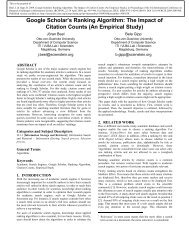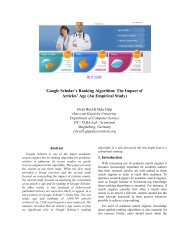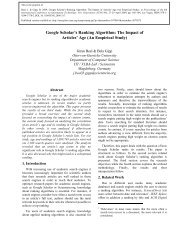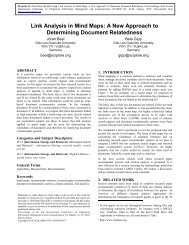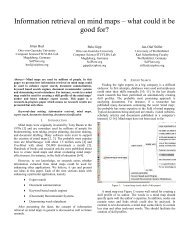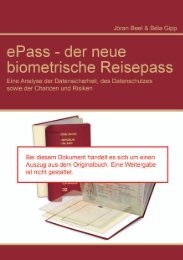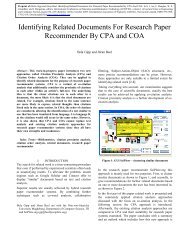Academic Search Engine Optimization (ASEO ... - Jöran Beel
Academic Search Engine Optimization (ASEO ... - Jöran Beel
Academic Search Engine Optimization (ASEO ... - Jöran Beel
You also want an ePaper? Increase the reach of your titles
YUMPU automatically turns print PDFs into web optimized ePapers that Google loves.
Preprint of: Joeran <strong>Beel</strong>, Bela Gipp, and Erik Wilde. <strong>Academic</strong> <strong>Search</strong> <strong>Engine</strong> <strong>Optimization</strong> (<strong>ASEO</strong>): Optimizing Scholarly Literature for Google Scholar andCo. Journal of Scholarly Publishing, 41 (2): 176–190, January 2010. doi: 10.3138/jsp.41.2.176. University of Toronto Press. Downloaded fromwww.docear.orgVisit www.docear.org for more of our papers about Google Scholar, <strong>Academic</strong> <strong>Search</strong> <strong>Engine</strong> Spam, and <strong>Academic</strong> <strong>Search</strong> <strong>Engine</strong> <strong>Optimization</strong><strong>Academic</strong> <strong>Search</strong> <strong>Engine</strong> <strong>Optimization</strong> (<strong>ASEO</strong>): OptimizingScholarly Literature for Google Scholar & Co.Joeran <strong>Beel</strong>UC BerkeleySchool of Informationjbeel@berkeley.eduBela GippUC BerkeleySchool of Informationgipp@berkeley.eduErik WildeUC BerkeleySchool of Informationdret@berkeley.eduABSTRACTThis article introduces and discusses the concept of academicsearch engine optimization (<strong>ASEO</strong>). Based on three recentlyconducted studies, guidelines are provided on how to optimizescholarly literature for academic search engines in general andfor Google Scholar in particular. In addition, we briefly discussthe risk of researchers’ illegitimately ‘over-optimizing’ theirarticles.Keywordsacademic search engines, academic search engine optimization,<strong>ASEO</strong>, Google Scholar, ranking algorithm, search engineoptimization, SEO1. INTRODUCTIONResearchers should have an interest in ensuring that their articlesare indexed by academic search engines 1 such as Google Scholar,IEEE Xplore, PubMed, and SciPlore.org, which greatly improvestheir ability to make their articles available to the academiccommunity. Not only should authors take an interest in seeingthat their articles are indexed, they also should be interesting inwhere the articles are displayed in the results list. Like any othertype of ranked search results, articles displayed in top positionsare more likely to be read.This article presents the concept of academic search engineoptimization (<strong>ASEO</strong>) to optimize scholarly literature foracademic search engines. The first part of the article coversrelated work that has been done mostly in the field of generalsearch engine optimization for Web pages. The second partdefines <strong>ASEO</strong> and compares it to search engine optimization forWeb pages. The third part provides an overview of rankingalgorithms of academic search engines in general, followed by anoverview of Google Scholar’s ranking algorithm. Finally,guidelines are provided on how authors can optimize theirarticles for academic search engines. This article does not coverhow publishers or providers of academic repositories canoptimize their Web sites and repositories for academic searchengines. The guidelines are based on three studies we haverecently conducted [1-3] and on our experience in developing theacademic search engine SciPlore.org.1In this article we do not distinguish between ‘academicdatabases’ and ‘academic search engines’; the latter term isused as synonym for both.2. RELATED WORKOn the Web, search engine optimization (SEO) for Web sites is acommon procedure. SEO involves creating or modifying a Website in a way that makes it ‘easier for search engines to bothcrawl and index [its] content’ [4]. There exists a huge communitythat discusses the latest trends in SEO and provides advice forWebmasters in forums, blogs, and newsgroups. 2 Even researcharticles and books exist on the subject of SEO [5-10]. When SEObegan, many expressed their concerns that it would promotespam and tweaking, and, indeed, search-engine spam is a seriousissue [11-26]. Today, however, SEO is a common and widelyaccepted procedure and overall, search engines manage toidentify spam quite well. Probably the strongest argument forSEO is the fact that search engines themselves publish guidelineson how to optimize Web sites for search engines [4, 27]. Butsimilar information on optimizing scholarly literature foracademic search engines does not exist, to our knowledge. 32.1 Introduction to <strong>Academic</strong> <strong>Search</strong> <strong>Engine</strong><strong>Optimization</strong> (<strong>ASEO</strong>)Based on the definition of search engine optimization for Webpages (SEO), we define academic search engine optimization(<strong>ASEO</strong>) as follows:<strong>Academic</strong> search engine optimization (<strong>ASEO</strong>) is the creation,publication, and modification of scholarly literature in away that makes it easier for academic search engines to bothcrawl it and index it.<strong>ASEO</strong> differs from SEO in four significant respects. First, forWeb search, Google is the market leader in most (Western)countries [28]. This means that for Webmasters (focusing onWestern Internet users), it is generally sufficient to optimize theirWeb sites for Google. In contrast, no such market leader existsfor searching academic articles, and researchers would need to2 E.g. http://www.abakus-internet-marketing.de/forenhttp://www.highrankings.com/forumhttp://www.seo-guy.com/forumhttp://www.seomoz.org/bloghttp://www.seo.com/bloghttp://www.abakus-internet-marketing.de/seoblog3 Google Scholar offers some information for publishers on howto get their articles indexed by Google Scholar and ranked well[35]. However, this information is superficial in comparison toother SEO articles, and the information is not aimed at authors.
optimize their articles for several academic search engines. Ifthese search engines are based on different crawling and rankingmethods, optimization can become complicated.Second, Webmasters usually do not need to worry about whethertheir site is indexed by a search engine: as long as any Web pageis linked to an already indexed page, it will be crawled andindexed by Web search engines at some point. The situation isdifferent in academia, where only a fraction of all publishedmaterial is available on the Web and accessible to Web-basedacademic search engines such as CiteSeer. Most academicarticles are stored in publishers’ databases; they are part of the‘academic invisible web,’ [29] and (academic) search enginesusually cannot access and index these articles. A few academicsearch engines, such as Scirus and Google Scholar, cooperatewith publishers, but still they do not cover all existing articles[30-32]. Researchers therefore need to think seriously about howto get their articles indexed by academic search engines.Third, Webmasters can alter their pages by adding or replacingwords and links, deleting pages, offering multiple versions withslight variations, and so on; in this way they can test newmethods and adapt to changes in ranking algorithms. Scholarlyauthors can hardly do so: once an article is published, it isdifficult and sometimes impossible to alter it. Therefore, <strong>ASEO</strong>needs to be performed particularly carefully.Finally, Web search engines usually index all text on a Web site,or at least the majority of it. In contrast, some academic searchengines do not index a document’s full text but instead indexonly the title and abstract. This means that for some academicsearch engines authors need to focus on the article’s title andabstract, but in other cases they still have to consider the full textfor other search engines.2.2 An Overview of <strong>Academic</strong> <strong>Search</strong><strong>Engine</strong>s’ Ranking AlgorithmsThe basic concept of keyword-based searching is the same for allmajor (academic) search engines. Users search for a search termin a certain document field (e.g., title, abstract, body text), or inall fields, and all documents containing the search term are listedon the results page. <strong>Academic</strong> search engines use differentranking algorithms to determine in which position the results aredisplayed. Some let the user choose one factor on which to rankthe results (common ranking factors are publication date, citationcount, author or journal name and reputation, and relevance ofthe document); others combine the ranking factors into onealgorithm, and, more often than not, the user has no influence onthe factor’s weighting.The relevance of a document is basically a function of how oftenthe search term occurs in that document and in which part of thedocument it occurs. Generally speaking, the more often a searchterm occurs in the document, and the more important thedocument field is in which the term occurs, the more relevant thedocument is considered 4 . This means that an occurrence in thetitle is weighted more heavily than an occurrence in the abstract,4 Some algorithms, such as the BM25(f ), saturate when a wordoccurs often in the text [36].which carries more weight than an occurrence in a (sub)heading,than in the body text, and so on. Possible document fields thatmay be weighted differently by academic search engines are: 5TitleAuthor namesAbstract(Sub)headingsAuthor keywordsBody textTables and figuresPublication name (name of journal, conference,proceedings, book, etc.)User keywords (Social tags)Social annotationsDescriptionFilenameURIThe metadata of electronic files are especially important foracademic search engines crawling the Web. When a searchengine finds a PDF on the Web, it does not know whether thisPDF represents an academic article, or which one it belongs to;therefore, the PDF must be identified, and one way to do this isby extracting the author and title. This can be done by analyzingthe full text of the document or the metadata of the PDF.It is also important to note that text in figures and tables usuallyis indexed only if it is embedded as real text or within a vectorgraphic. If text is embedded as a raster graphic (e.g., *.bmp,*.png, *.gif, *.tif, *.jpg), most, if not all, search engines will notindex the text (see Figures 1 and 2 for an illustration ofdifferences between vector and raster/bitmap graphics). 6 To ourknowledge, none of the major academic search engines currentlyconsiders synonyms. This means that a document containing onlythe term ‘academic search engine’ would not be found via asearch for ‘scientific paper search engine’ or ‘academicdatabase.’ What most academic search engines do is stemming:words are reduced to their stems (e.g., ‘analysed’ and ‘analysing’would be reduced to ‘analyse’).2.3 Google Scholar’s Ranking AlgorithmGoogle Scholar is one of those search engines that combineseveral factors into one ranking algorithm. The most importantfactors are relevance, citation count, author name(s), and name ofpublication. 75 Some of the data could be retrieved from the document fulltext, other from the metadata (of electronic files)6Theoretically search engines could index the text inraster/bitmap graphics, but they would have to apply opticalcharacter recognition (OCR). To our knowledge, no searchengine currently does this, although some are using OCR toindex complete scans of scholarly literature.7 Google Scholar offers different search functions. For instance, itis possible to search for ‘related articles’ and ‘recent articles.’In this article we focus on the normal ranking algorithm, whichis applied for the standard keyword search.
Citation Counts2.3.1 RelevanceGoogle Scholar focuses strongly on document titles. Documentscontaining the search term in the title are likely to be positionednear the top of the results list. Google Scholar also seems toconsider the length of a title: In a search for the term ‘SEO,’ adocument titled ‘SEO: An Overview’ would be ranked higherthan one titled ‘<strong>Search</strong> <strong>Engine</strong> <strong>Optimization</strong> (SEO): A LiteratureSurvey of the Current State of the Art.’Although Google Scholar indexes entire documents, the totalsearch term count in the document has little or no impact. In asearch for ‘recommender systems,’ a document containing fiftyinstances of this term would not necessarily be ranked higherthan a document containing only ten instances.All this is possible because this figure is a vector graphicStartIf you are currentlyreading this document inelectronic form (e.g.PDF), enlarge it and seewhat happens…You could also search for theterm "aseoVectorExample" inGoogle Scholar, Google or other(academic) search engines andyou will find this documentThis figure (including all text andshapes) should scale and shouldbe still well readable.well readable.You should also beable to mark this textand copy it, forinstance, to yourword processingsoftwareFigure 1: Example of a Vector GraphicLike other search engines, Google Scholar does not index text infigures and tables inserted as raster/bitmap graphics, but it doesindex text in vector graphics. It is also known that neithersynonyms nor PDF metadata are considered.2.3.2 Citation CountsCitation counts play a major role in Google Scholar’s rankingalgorithm, as illustrated in Figure 3, which shows the meancitation count for each position in Google Scholar. 8 It is clearthat, on average, articles in the top positions have significantlymore citations than articles in the lowest positions. This meansthat to achieve a good ranking in Google Scholar, many citationsare essential. Google Scholar seems not to differentiate betweenself-citations and citations by third parties.8 On average, articles at position 1 had 834 citations, articles atposition 2 had 552, articles at position 3 had 426, and articlesat position 1000 had fifty-three. The study was based on1,032,766 results produced by 1050 search queries inNovember 2008. For more detail see [1].Figure 2: Example of a Bitmap Graphic2.3.3 Author and Publication NameIf the search query includes an author or publication name, adocument in which either appears is likely to be ranked high. Forinstance, seventy-four of the top 100 results of a search for‘arteriosclerosis and thrombosis cure’ were articles about various(medical) topics from the journal Arteriosclerosis, Thrombosis,and Vascular Biology, many of which did not include the searchterm either in the title or in the full text [2].50040030020010000 250 500 750 1000Position in Google ScholarFigure 3: Mean Citation Count per Position 82.3.4 Other factorsGoogle Scholar’s standard search does not consider publicationdates. However, Google Scholar offers a special search functionfor ‘recent articles,’ which limits results to articles publishedwithin the past five years. Furthermore, Google Scholar claims toconsider both publication and author reputation [33]. However,we could not research the influence of these factors because of alack of data, and therefore we do not consider them here.
2.3.5 Sources Indexed by Google ScholarBert van Heerde, a professional in the field of SEO, uses theterm ‘invitation based search engine’ to describe Google Scholar:Only articles from trusted sources and articles that are ‘invited’(cited) by articles already indexed are included in the database[34]. ‘Trusted sources,’ in this case, are publishers that cooperatedirectly with Google Scholar, as well as publishers andWebmasters who have requested that Google Scholar crawl theirdatabases and Web sites. 9Once an article is included in Google Scholar’s database, GoogleScholar searches the Web for corresponding PDF files, even if atrusted publisher has already provided the full text. 10 It makes nodifference on which site the PDF is published; for instance,Google Scholar has indexed PDF files of our articles from thepublisher’s site, our university’s site, our private home pages,and SciPlore.org. PDFs found on the Web are linked directly onGoogle Scholar’s results pages, in addition to the link to thepublisher’s full text (see Figure 4 for an illustrative example).Figure 4: Linking database entries with external PDFsIf different PDF files of an article exist, Google Scholar groupsthem to improve the article’s ranking [35]. For instance, if apreprint version of an article is available on the author’s Webpage and the final version is available on the publisher’s site,Google indexes both as one version. If the two versions containdifferent words, Google Scholar associates all contained wordswith the article. This is an interesting feature that we willdiscuss in more detail in the next section.3. OPTIMIZING SCHOLARLYLITERATURE FOR GOOGLE SCHOLARAND OTHER ACADEMIC SEARCHENGINES3.1 PreparationIn the beginning it is necessary to think about the most importantwords that are relevant to the article. It is not possible tooptimize one document for dozens of keywords, so it is better tochoose a few. There are tools that help in selecting the rightkeywords, such as Google Trends, Google Insights, GoogleAdwords keyword tool, Google <strong>Search</strong>–based keyword tool, andSpacky. 119 Visit http://www.google.com/support/scholar/bin/request.py toask Google Scholar to crawl your Web site containing scholarlyarticles.10Google Scholar also indexes other file types, such asPostScript (*.ps), Microsoft Word (*.doc), and MS PowerPoint(*.ppt). Here we focus on PDF, which is the most commonformat for scientific articles.11 Google Trends http://www.google.com/trendsGoogle Insights http://www.google.com/insights/search/It might be wise not to select those keywords that are mostpopular. It is usually a good idea to query the common academicsearch engines using each proposed keyword; if the searchalready returns hundreds of documents, it may be better tochoose another keyword with less competition. 123.2 Writing Your ArticleOnce the keywords are chosen, they need to be mentioned in theright places: in the title, and as often as possible in the abstractand the body of the text (but, of course, not so often as to annoyreaders). Although in general titles should be fairly short, wesuggest choosing a longer title if there are many relevantkeywords.Synonyms of important keywords should also be mentioned a fewtimes in the body of the text, so that the article may be found bysomeone who does not know the most common terminology usedin the research field. If possible, synonyms should also bementioned in the abstract, particularly because some academicsearch engines do not index the document’s full text.Be consistent in spelling people’s names, taking special carewith names that contain special characters. If names are usedinconsistently, search engines may not be able to identify articlesor citations correctly; as a consequence, citations may beassigned incorrectly, and articles will not be as highly ranked asthey could be. For instance, Jöran, Joeran, and Joran are allcorrect spellings of the same name (given different transcriptionrules), but Google Scholar sees them as three different names.The article should use a common scientific layout and structure,including standard sections: introduction, related work, results,and so on. A common scientific layout and structure will helpWeb-based academic search engines to identify an article asscientific.<strong>Academic</strong> search engines, and especially Google Scholar, assignsignificant weight to citation counts. Citations influence whetherarticles are indexed at all, and they also influence the ranking ofarticles. We do not want to encourage readers to build ‘citationcircles,’ or to take any other unethical action. But any publishedarticles you have read that relate to your current research papershould be cited. When referencing your own published work, it isimportant to include a link where that work can be downloaded.This helps readers to find your article and helps academic searchengines to index the referenced article’s full text. Of course, thiscan also be done for other articles that have well-known (i.e.,stable and possibly canonical) download locations.3.3 Preparing for PublicationText in figures and tables should be machine readable (i.e.,vector graphics containing font-based text should be used insteadGoogle Adwordshttps://adwords.google.com/select/KeywordToolExternal;Google keyword tool, http://google.com/sktool/Spacky, http://www.spacky.com12 For example, keywords such as ‘Web’ and ‘HTML’ may be oflimited use because there are too many papers published in thatspace, in which case it makes more sense to narrow the scopeand choose better-differentiated keywords.
models, he has recently shifted his main focus to information andapplication architecture, mobile applications, geo-location issueson the Web, and how to design data sharing that is open andaccessible for many different service consumers.REFERENCES[1] Jöran <strong>Beel</strong> and Bela Gipp. Google Scholar’s RankingAlgorithm: The Impact of Citation Counts (An Empirical Study).In André Flory and Martine Collard, editors, Proceedings of the3rd IEEE International Conference on Research Challenges inInformation Science (RCIS’09), pages 439–446, Fez (Morocco),April 2009. IEEE. doi: 10.1109/RCIS.2009.5089308. ISBN 978-1-4244-2865-6. Available on http://www.sciplore.org.[2] Jöran <strong>Beel</strong> and Bela Gipp. Google Scholar’s RankingAlgorithm: An Introductory Overview. In Birger Larsen andJacqueline Leta, editors, Proceedings of the 12th InternationalConference on Scientometrics and Informetrics (ISSI’09),volume 1, pages 230–241, Rio de Janeiro (Brazil), July 2009.International Society for Scientometrics and Informetrics. ISSN2175-1935. Available on http://www.sciplore.org.[3] Jöran <strong>Beel</strong> and Bela Gipp. Google Scholar’s RankingAlgorithm: The Impact of Articles’ Age (An Empirical Study). InShahram Latifi, editor, Proceedings of the 6th InternationalConference on Information Technology: New Generations(ITNG’09), pages 160–164, Las Vegas (USA), April 2009. IEEE.doi: 10.1109/ITNG.2009.317. ISBN 978-1424437702. Availableon http://www.sciplore.org.[4] Google. Google’s <strong>Search</strong> <strong>Engine</strong> <strong>Optimization</strong> Starter Guide.PDF, November 2008. URL http://www.google.com/-webmasters/docs/search-engine-optimization-starter-guide.pdf.[5] Albert Bifet and Carlos Castillo. An Analysis of Factors Usedin <strong>Search</strong> <strong>Engine</strong> Ranking. In Proceedings of the 14thInternational World Wide Web Conference (WWW2005), FirstInternational Workshop on Adversarial Information Retrieval onthe Web (AIRWeB’05), 2005.http://airweb.cse.lehigh.edu/2005/bifet.pdf.[6] Michael P. Evans. Analysing Google rankings through searchengine optimization data. Internet Research, 17 (1): 21–37, 2007.doi: 10.1108/10662240710730470.[7] Jin Zhang and Alexandra Dimitroff. The impact of metadataimplementation on webpage visibility in search engine results(Part II). Cross-Language Information Retrieval, 41 (3): 691–715, May 2005.[8] Harold Davis. <strong>Search</strong> <strong>Engine</strong> <strong>Optimization</strong>. O’Reilly, 2006.[9] Jennifer Grappone and Gradiva Couzin. <strong>Search</strong> <strong>Engine</strong><strong>Optimization</strong>: An Hour a Day. John Wiley and Sons, 2nd edition,2008.[10] Peter Kent. <strong>Search</strong> engine optimization for dummies. WilleyPublishing Inc, 2006.[11] AA Benczur, K Csalogány, T Sarlós, and M Uher.SpamRank – Fully Automatic Link Spam Detection. InAdversarial Information Retrieval on the Web (AiRWEB’05),2005.[12] A. Benczúr, K. Csalogány, and T. Sarlós. Link-basedsimilarity search to fight web spam. Adversarial InformationRetrieval on the Web (AIRWEB), Seattle, Washington, USA,2006.[13] I. Drost and T. Scheffer. Thwarting the nigritudeultramarine: Learning to identify link spam. Lecture Notes inComputer Science, 3720: 96, 2005.[14] D. Fetterly, M. Manasse, and M. Najork. Spam, damn spam,and statistics: Using statistical analysis to locate spam webpages. pages 1–6, 2004.[15] Q. Gan and T. Suel. Improving web spam classifiers usinglink structure. In Proceedings of the 3rd international workshopon Adversarial information retrieval on the web, page 20. ACM,2007.[16] Z. Gyöngyi and H. Garcia-Molina. Link spam alliances. InProceedings of the 31st international conference on Very largedata bases, page 528. VLDB Endowment, 2005.[17] H. Saito, M. Toyoda, M. Kitsuregawa, and K. Aihara. Alarge-scale study of link spam detection by graph algorithms. InProceedings of the 3rd international workshop on Adversarialinformation retrieval on the web, page 48. ACM, 2007.[18] B. Wu and K. Chellapilla. Extracting link spam using biasedrandom walks from spam seed sets. In Proceedings of the 3rdinternational workshop on Adversarial information retrieval onthe web, page 44. ACM, 2007.[19] C. Castillo, D. Donato, A. Gionis, V. Murdock, andF. Silvestri. Know your neighbors: Web spam detection using theweb topology. In Proceedings of the 30th annual internationalACM SIGIR conference on Research and development ininformation retrieval, page 430. ACM, 2007.[20] G.G. Geng, C.H. Wang, and Q.D. Li. ImprovingSpamdexing Detection Via a Two-Stage Classification Strategy.page 356, 2008.[21] I.S. Nathenson. Internet infoglut and invisible ink:Spamdexing search engines with meta tags. Harv. J. Law & Tec,12: 43–683, 1998.[22] T. Urvoy, E. Chauveau, P. Filoche, and T. Lavergne.Tracking web spam with HTML style similarities. ACMTransactions on the Web (TWEB), 2, 2008.[23] T. Urvoy, T. Lavergne, and P. Filoche. Tracking web spamwith hidden style similarity. In AIRWeb 2006, page 25, 2006.[24] Masahiro Kimura, Kazumi Saito, Kazuhiro Kazama, andShin ya Sato. Detecting <strong>Search</strong> <strong>Engine</strong> Spam from a TrackbackNetwork in Blogspace. Lecture Notes in Computer Science:Knowledge-Based Intelligent Information and <strong>Engine</strong>eringSystems, 3684: 723–729, 2005. doi: 10.1007/11554028_101.[25] Alexandros Ntoulas, Marc Najork, Mark Manasse, andDennis Fetterly. Detecting spam web pages through contentanalysis. In 15th International Conference on World Wide Web,pages 83–92. ACM, 2006.[26] Baoning Wu and Brian D. Davison. Identifying link farmspam pages. In 14th International Conference on World WideWeb, pages 820–829, 2005.
[27] Yahoo! How do I improve the ranking of my web site in thesearch results?, July 2007. URL http://help.yahoo.com/l/us/-yahoo/search/indexing/ranking-02.html.[28] Alex Chitu. Google’s Market Share in Your Country.Website, March 2009. URL http://googlesystem.blogspot.com/-2009/03/googles-market-share-in-your-country.html https://-spreadsheets.google.com/-ccc?key=pLaE9tsVLp_0y1FKWBCKGBA.[29] D. Lewandowski and P. Mayr. Exploring the academicinvisible web. Library Hi Tech, 24 (4): 529–539, 2006.[30] Nisa Bakkalbasi, Kathleen Bauer, Janis Glover, and LeiWang. Three options for citation tracking: Google Scholar,Scopus and Web of Science. Biomedical Digital Libraries, 3,2006. doi: 10.1186/1742-5581-3-7.[31] John J. Meier and Thomas W. Conkling. Google Scholar’sCoverage of the <strong>Engine</strong>ering Literature: An Empirical Study. TheJournal of <strong>Academic</strong> Librarianship, 34 (34): 196–201, 2008.[32] William H. Walters. Google Scholar coverage of amultidisciplinary field. Information Processing & Management,43 (4): 1121–1132, July 2007. doi:doi:10.1016/j.ipm.2006.08.006.[33] Google. About Google Scholar. Website, 2008. URL http://-scholar.google.com/intl/en/scholar/about.html.[34] Bert van Heerde. RE: Pre-print: <strong>Academic</strong> <strong>Search</strong> <strong>Engine</strong><strong>Optimization</strong>. Email, 3 September 2009.[35] Google Scholar. Support for Scholarly Publishers. Website,2009. URL http://scholar.google.com/intl/en/scholar/-publishers.html.[36] S. Robertson, H. Zaragoza, and M. Taylor. Simple BM25extension to multiple weighted fields. In Proceedings of thethirteenth ACM international conference on Information andknowledge management, pages 42–49. ACM New York, NY,USA, 2004.



